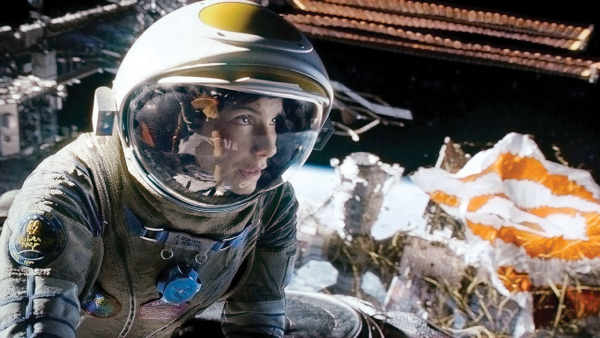Movie review by Greg Carlson
A hair-raising survivor thriller, Alfonso Cuaron’s “Gravity” imagines the deadly consequences of the Kessler effect on a shuttle mission spacewalk endangered by projectile debris. At the risk of drawing fire from the enthusiastic moviegoers who made “Gravity” the most successful October film opening to date, the movie does not surpass the intellectual and emotional engagement of Cuaron’s brilliant, blistering “Children of Men,” although for many, the fierce determination and will to live expressed by stranded astronaut Ryan Stone (Sandra Bullock) will sets heart to pounding. “Gravity” is still better than good. Along with Emmanuel Lubezki’s phenomenal work as director of photography, the visual design certainly heralds another milestone in the development of photorealistic CGI.
“Gravity” is so direct, so focused on the life-sustaining importance of critical tasks performed step by detailed step, one wonders whether or how philosopher and Cuaron fan Slavoj Zizek will apply the “paradox of anamorphosis” to the new film. Zizek’s fascination with the idea that meaning in “Children of Men” can be derived only from examining the background and the margins – as opposed to the principal elements of plot that dominate the foreground and the action – invites a kind of discourse that must be altered for discussions of “Gravity.” Of course, it is entirely possible that Zizek could surprise us all with a claim that the chasm of space functions in a manner parallel to Cuaron’s previous efforts, but I for one see the filmmaker’s latest as a canny, calculating blend of technological experimentation and classic Hollywood formalism, the latter most disappointingly embodied by Steven Price’s often-standard issue score.
As one of the biggest movie stories of 2013, “Gravity” has already generated a metanarrative constructed by people interested in the intricacies of the production process as much as the drama of Dr. Stone’s predicament (the last time this happened on a similar scale may have been “Avatar”). Celebrity astrophysicist Neil deGrasse Tyson posted a series of comments on Twitter popping a few holes in the movie’s logic balloon. The items called out ranged from minor, possibly aesthetic issues (why Bullock’s hair didn’t float in zero-G) to questions of positioning (Hubble, the International Space Station and a Chinese rig are “all in sight lines of one another”) to several other matters of plausibility. From a storytelling standpoint, one can chalk the entire lot of Tyson’s observations up to the most basic rights of artistic license. The popular scientist also made sure to note that he enjoyed the film “very much.”
No potentially groundbreaking movie dealing with space exploration can escape the inevitable comparison to “2001: A Space Odyssey,” and “Gravity” reviewers have lined up to pay their respects to Stanley Kubrick’s landmark. Kubrick’s film, no less meticulous in its own approach to orbital verisimilitude, was sui generis in a way that “Gravity” cannot claim. Andrew O’Hehir even suggests that “Gravity” is like a “secular equivalent to the spiritual or supernatural dimension found in Kubrick’s and Tarkovsky’s great space movies.” Both “Gravity” and “2001” have a way of defining the terrifying immediacy of an astronaut’s fragile tightrope walk between life and death, but Cuaron – with one notable exception – chooses not to float toward the metaphysical phantasmagoria so indelibly conjured by Kubrick.
